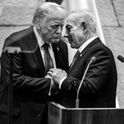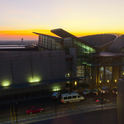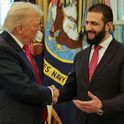An image from Hala Elkoussy’s work 'Myths and Legends Room: The Mural,' on display at the Chamber Exhibition Space in Camberwell
Few, if any, political analysts predicted the Arab Spring. The raw energy of millions of protestors in the streets of Tunis and Cairo came as a surprise to many who believed that Arabs were essentially reconciled to their governments and non-democratic rule. Yet the signs had been there for some time—in the contemporary Arab art emerging from the region. A new generation of artists, film-makers, musicians, designers, playwrights and poets had been making work for years that expressed the yearning manifest in the uprisings.
Currently on show at the Delfina Foundation in London, Wael Shawky’s ‘The Larvae Channel" (2008) is a prescient video piece that explores the tensions bubbling beneath the surface of Egyptian society. Ordinary individuals are invited to speak into the camera on whichever subject they choose. Without exception, they complain about the government and the sense of tragic despair that accompanies tyranny. One young man becomes so worked up about the state of the nation that he insists that the interviewer go tell the government, religious leaders, or anyone who will listen. He is so enraged that he even gives his address, unafraid of the repercussions. Such desperation, beautifully filmed, reveals in hindsight the promise of change.
Shawky is just one of a number of artists who have benefited from the expansion of the global art market in the last decade and the increasingly international outlook of major cultural institutions. Many organisations like the Tate, British Museum, and V&A have looked to build their Middle East collections, whilst large venues such as the Young Vic, Barbican, Southbank and Sadlers Wells have brought over Arab musicians, theatre companies and writers.
Now these artists are in the spotlight, with a London festival running from 4-24th July called “Shubbak: A Window on Contemporary Arab Culture.” At a time when the Arab world is changing fast, an initiative like this can go a long way to challenging preconceptions, showcasing both familiar names (such as the novelists Hisham Matar and Adhaf Soueif) as well as less well-known talents (such as the award-winning Lebanese-American photographer Rania Matar, or Egyptian, Ramy Essam, whose songs performed on Tahrir Square formed the soundtrack to the revolt).
There is much disagreement about what Arab art is and who defines it; governments are just as aware of the importance of art in building a county’s identity as well as expressing dissent. The Gulf nations in particular have invested millions in national museums and art galleries to enhance their international prestige and increase tourism. In its first appearance at the Venice Biennale in 2008, the UAE pavilion was curated by Tirdad Zolghadr who used the opportunity to make light of the way "new" nations feel obliged to use art to present themselves to the world, and the paternalistic reaction of older nations at their attempts—"It’s not you, it’s me" joked the accompanying text for the show. In 2011, the Egypt pavilion openly confronted its recent history by showing the work of 32-year-old Ahmed Basiony, an artist killed during the demonstrations.
Yet the most interesting developments have often flourished at the margins. The Townhouse Gallery of Contemporary Art, started in 1998 in Cairo, is an independent space showcasing local residents in participation projects, talks, and discussions. Located in an old industrial district, the Townhouse explores subjects as diverse as Egyptian surrealism, graphic design, and urban change. It is a social enterprise as much as an art space.
This story is repeated across the Arab world, in cities as diverse as Ramallah, Aleppo, Beirut and Dubai. Jack Persekian, the highly respected visual arts curator, started his art career in the 1990s by setting up the first independent space, the Anadiel Gallery, in Palestine as a way to support younger practitioners who felt sidelined by Palestinian officialdom. In 2005, Persekian was recruited as curator of the Sharjah Biennial, eventually heading up the Foundation under which it was organised. His vision helped transform the Biennial from a good but fairly local event, to a global player which could attract curators, journalists and artists from much further afield.
Crucially, these developments have challenged the lazy assumption that Arab art is ‘safe,’ antiquated or full of religious dogma, and has led to an interest in rescuing its forgotten art history—that of the Arab world’s fruitful engagement with modernism. Mathaf, the Arab Museum of Modern Art which opened in Doha in 2011, positions Arab art from the 1840s onwards within the context of the dominant trends in the art world, rather than in a ghetto called ‘ethnic’ or ‘culturally diverse’ art. The museum is a treasure trove of works that would hold their own in any of the major national museums in the west. For so long, Arab culture has been misconceived by the western mindset as exotic, or more recently, as dangerous, so spaces like Mathaf are vital for asserting a sense of connectedness.
Yet there is still caution on both sides. Western curators were reminded of the religious and political sensitivities in the Arab world when in April this year, Persekian had to resign from the Sharjah Art Foundation after exhibiting a piece in the Biennial deemed blasphemous by law. The sensitivity around religious controversy is no doubt intensified because of the fear of uprisings and the concern to maintain order. On the other side, there remains some suspicion in the Arab arts world that western curators and institutions are paternalistic in their approach to Arab countries, seeing them as a source of funding, or hyping them up as a new fashion, rather than stepping back to allow a local, more critical scene to grow.
As cultural relations develop, there needs to be a willingness on both sides to see beyond the stereotype. Shubbak will surely help; it includes "Interference" at the ICA, a free weekend of talks, workshops, and debates about art and politics, agency and agitation in the Arab world and beyond. The themes are as relevant to Britain as they are to the Arab world. If such dialogue and a spirit of mutual trust can develop in London and other cities over the coming months, the Arab spring may yet develop into an Arab summer.
Shubbak: A Window on Contemporary Arab Culture runs from 4-24th July across multiple venues in London. Click here for more information. Organised by the Mayor of London’s Office and sponsored by HSBC.
Few, if any, political analysts predicted the Arab Spring. The raw energy of millions of protestors in the streets of Tunis and Cairo came as a surprise to many who believed that Arabs were essentially reconciled to their governments and non-democratic rule. Yet the signs had been there for some time—in the contemporary Arab art emerging from the region. A new generation of artists, film-makers, musicians, designers, playwrights and poets had been making work for years that expressed the yearning manifest in the uprisings.
Currently on show at the Delfina Foundation in London, Wael Shawky’s ‘The Larvae Channel" (2008) is a prescient video piece that explores the tensions bubbling beneath the surface of Egyptian society. Ordinary individuals are invited to speak into the camera on whichever subject they choose. Without exception, they complain about the government and the sense of tragic despair that accompanies tyranny. One young man becomes so worked up about the state of the nation that he insists that the interviewer go tell the government, religious leaders, or anyone who will listen. He is so enraged that he even gives his address, unafraid of the repercussions. Such desperation, beautifully filmed, reveals in hindsight the promise of change.
Shawky is just one of a number of artists who have benefited from the expansion of the global art market in the last decade and the increasingly international outlook of major cultural institutions. Many organisations like the Tate, British Museum, and V&A have looked to build their Middle East collections, whilst large venues such as the Young Vic, Barbican, Southbank and Sadlers Wells have brought over Arab musicians, theatre companies and writers.
Now these artists are in the spotlight, with a London festival running from 4-24th July called “Shubbak: A Window on Contemporary Arab Culture.” At a time when the Arab world is changing fast, an initiative like this can go a long way to challenging preconceptions, showcasing both familiar names (such as the novelists Hisham Matar and Adhaf Soueif) as well as less well-known talents (such as the award-winning Lebanese-American photographer Rania Matar, or Egyptian, Ramy Essam, whose songs performed on Tahrir Square formed the soundtrack to the revolt).
There is much disagreement about what Arab art is and who defines it; governments are just as aware of the importance of art in building a county’s identity as well as expressing dissent. The Gulf nations in particular have invested millions in national museums and art galleries to enhance their international prestige and increase tourism. In its first appearance at the Venice Biennale in 2008, the UAE pavilion was curated by Tirdad Zolghadr who used the opportunity to make light of the way "new" nations feel obliged to use art to present themselves to the world, and the paternalistic reaction of older nations at their attempts—"It’s not you, it’s me" joked the accompanying text for the show. In 2011, the Egypt pavilion openly confronted its recent history by showing the work of 32-year-old Ahmed Basiony, an artist killed during the demonstrations.
Yet the most interesting developments have often flourished at the margins. The Townhouse Gallery of Contemporary Art, started in 1998 in Cairo, is an independent space showcasing local residents in participation projects, talks, and discussions. Located in an old industrial district, the Townhouse explores subjects as diverse as Egyptian surrealism, graphic design, and urban change. It is a social enterprise as much as an art space.
This story is repeated across the Arab world, in cities as diverse as Ramallah, Aleppo, Beirut and Dubai. Jack Persekian, the highly respected visual arts curator, started his art career in the 1990s by setting up the first independent space, the Anadiel Gallery, in Palestine as a way to support younger practitioners who felt sidelined by Palestinian officialdom. In 2005, Persekian was recruited as curator of the Sharjah Biennial, eventually heading up the Foundation under which it was organised. His vision helped transform the Biennial from a good but fairly local event, to a global player which could attract curators, journalists and artists from much further afield.
Crucially, these developments have challenged the lazy assumption that Arab art is ‘safe,’ antiquated or full of religious dogma, and has led to an interest in rescuing its forgotten art history—that of the Arab world’s fruitful engagement with modernism. Mathaf, the Arab Museum of Modern Art which opened in Doha in 2011, positions Arab art from the 1840s onwards within the context of the dominant trends in the art world, rather than in a ghetto called ‘ethnic’ or ‘culturally diverse’ art. The museum is a treasure trove of works that would hold their own in any of the major national museums in the west. For so long, Arab culture has been misconceived by the western mindset as exotic, or more recently, as dangerous, so spaces like Mathaf are vital for asserting a sense of connectedness.
Yet there is still caution on both sides. Western curators were reminded of the religious and political sensitivities in the Arab world when in April this year, Persekian had to resign from the Sharjah Art Foundation after exhibiting a piece in the Biennial deemed blasphemous by law. The sensitivity around religious controversy is no doubt intensified because of the fear of uprisings and the concern to maintain order. On the other side, there remains some suspicion in the Arab arts world that western curators and institutions are paternalistic in their approach to Arab countries, seeing them as a source of funding, or hyping them up as a new fashion, rather than stepping back to allow a local, more critical scene to grow.
As cultural relations develop, there needs to be a willingness on both sides to see beyond the stereotype. Shubbak will surely help; it includes "Interference" at the ICA, a free weekend of talks, workshops, and debates about art and politics, agency and agitation in the Arab world and beyond. The themes are as relevant to Britain as they are to the Arab world. If such dialogue and a spirit of mutual trust can develop in London and other cities over the coming months, the Arab spring may yet develop into an Arab summer.
Shubbak: A Window on Contemporary Arab Culture runs from 4-24th July across multiple venues in London. Click here for more information. Organised by the Mayor of London’s Office and sponsored by HSBC.












